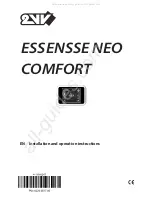
5-156
F35 MULTIPLE FEEDER PROTECTION SYSTEM – INSTRUCTION MANUAL
PRODUCT SETUP
CHAPTER 5: SETTINGS
5
Appendix A: FlexAnalog Parameters. The parameter index number shown in any of the tables is used to expedite the
selection of the parameter on the relay display. It can be time-consuming to scan through the list of parameters via the
relay keypad/display—entering this number via the relay keypad causes the corresponding parameter to display.
DATA LOGGER CONFIG
— This display presents the total amount of time that the Data Logger can record the channels not
selected to “Off” without overwriting old data.
5.3.11 Demand
SETTINGS
PRODUCT SETUTP
DEMAND
The relay measures current demand on each phase, and three-phase demand for real, reactive, and apparent power.
Current and Power methods can be chosen separately for the convenience of the user. Settings are provided to allow the
user to emulate common electrical utility demand measuring techniques, for statistical or control purposes. If the
CRNT
DEMAND METHOD
is set to "Block Interval" and the
DEMAND TRIGGER
is set to “Off,” Method 2 is used as follows. If
DEMAND
TRIGGER
is assigned to any other FlexLogic operand, Method 2a is used as follows.
The relay can be set to calculate demand by any of the following three methods.
5.3.11.1 Calculation method 1: Thermal exponential
This method emulates the action of an analog peak-recording thermal demand meter. The relay measures the quantity
(RMS current, real power, reactive power, or apparent power) on each phase every second and assumes that the circuit
quantity remains at this value until updated by the next measurement. It calculates the 'thermal demand equivalent'
based on the following equation:
Eq. 5-6
where
d = demand value after applying input quantity for time t (in minutes)
D = input quantity (constant)
k = 2.3 / thermal 90% response time
The figure shows the 90% thermal response time characteristic of 15 minutes. A setpoint establishes the time to reach
90% of a steady-state value, just as the response time of an analog instrument. A steady state value applied for twice the
response time indicates 99% of the value.
Figure 5-75: Thermal demand characteristic
DEMAND
CRNT DEMAND METHOD:
Thermal Exponential
Range: Thermal Exponential, Block Interval, Rolling
Demand
POWER DEMAND METHOD:
Thermal Exponential
Range: Thermal Exponential, Block Interval, Rolling
Demand
DEMAND INTERVAL:
15 MIN
Range: 5, 10, 15, 20, 30, 60 minutes
DEMAND TRIGGER:
Off
Range: FlexLogic operand
Note: for calculation using method 2a
















































